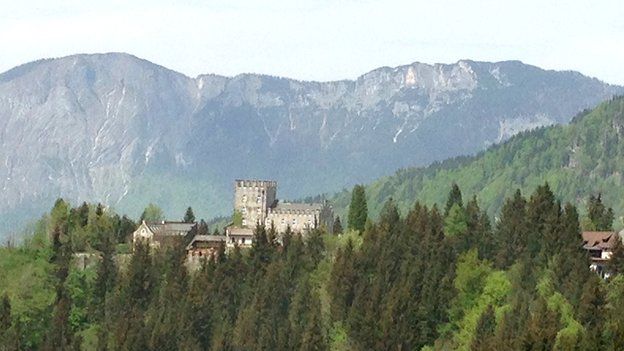The Austrian castle where Nazis lost to German-US force
- Published

Capturing Itter Castle was a tough challenge as Nazi troops were in the surrounding woods
Seventy years ago one of the most unlikely battles of World War Two took place, at Itter in the Austrian Alps.
In early May 1945, American and German soldiers fought together against the Nazi SS to free prominent French prisoners of war. It is believed to be the only battle in the war in which Americans and Germans fought as allies.
Hans Fuchs remembers how Itter Castle was converted into a prison by the Nazis in 1943.
"We saw everything from our school window," he said, "a double barbed-wire fence
Schloss Itter, which dates back to the Middle Ages, was a sub-unit of the Dachau concentration camp.
It was used for VIP prisoners, prominent politicians and military figures that the Nazis wanted to use as bargaining chips.
They included two former prime ministers of France, Edouard Daladier and Paul Reynaud, as well as the elder sister of Gen Charles de Gaulle, Marie-Agnes Cailliau.
In May 1945, the last days of the war in Europe, the German guards at Schloss Itter fled. But the French prisoners were trapped, as the woods around the castle were full of roaming units of the Waffen SS and Gestapo secret police.
The French sent out two prisoners on bicycles to find help.
Stephen Harding, author of the book The Last Battle, says one of them managed to contact a German major, Josef (Sepp) Gangl.
Maj Sepp Gangl of the Wehrmacht switched sides to help US forces
US Capt Jack Lee teamed up with Gangl's men to take on the SS
A highly decorated Wehrmacht officer, Gangl had become opposed to the Nazis and was collaborating with the Austrian resistance.
"Gangl realised he could not protect them [the prisoners], he only had about 20 soldiers who were loyal to him," Mr Harding said.
Taking a big white flag, Gangl met up with the closest American unit, the 23rd Tank Battalion of the US 12th Armoured Division, led by Capt Jack Lee.
Lee offered to lead a rescue mission to the castle.
SS attack
A small group of Americans, accompanied by Gangl and some of his men, made their way to Itter, parking their Sherman tank close to the castle entrance.
At dawn on 5 May, they were attacked by the Waffen SS, who blew up the US tank, but were unable to storm the castle.
Stephen Harding tells the story of the battle for Castle Itter
"There was only one casualty," says Mr Harding. "Josef Gangl was killed by a sniper."
Hans Fuchs, who was 14, watched the battle from his family's farm. "There was machine gun fire for hours," he said. "We saw clouds of dust and smoke."
That evening, once the fighting stopped, he went down towards the castle.
"The tank was still burning," he said. "I saw how around 100 SS men were taken prisoner
Schloss Itter was damaged in the fighting as this May 1945 photo shows
Josef Gangl was buried in the nearby town of Woergl. Today a street is named after him.
Mr Harding says the battle was decisive.
"If the SS had managed to get into the castle and kill the French VIPs, the history of post-war France would have been radically different. These people... formulated the policies that carried France into the 21st Century. Had they died, who knows what would have happened?"
France's Gen Maxime Weygand (right) and his wife leave the castle in this May 1945 photo
De Gaulle's sister Marie-Agnes Cailliau was among the French VIPs liberated from the Nazis
A memorial in nearby Woergl commemorates Sepp Gangl as a war hero